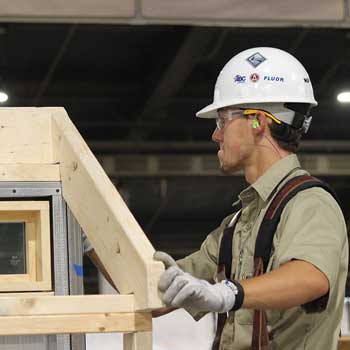As craft skills continue to rise in demand, schools have begun to recognize this need and are working to establish more career and technical education (CTE) programs to help students learn these skills and put them on a path to a career in specialized industries, such as construction.
This proves to be an effective transition as CTE programs do so much more than simply prepare students for jobs in the skilled crafts. These programs create higher graduation rates, increase understanding in science and math, teach critical soft skills and help students explore potential career paths.
With a need for 1 million craft professionals by 2023, there has never been a more important time to integrate these programs into schools. Here are the top four reasons why schools should prioritize CTE.

CTE in schools places an emphasis on career-readiness and hands-on learning. These aspects create a more engaging school environment that is linked to higher graduation rates among students.
When students are able to link traditional lessons to real-life applications that apply directly to students’ future careers, they are more invested in their learning and education. This helps them see the value of learning and encourages graduation.
In fact, the average high school graduation rate in 2012 for CTE students was 93%, compared to the national average of 80%.
This data shows that students who are given a chance to start working toward their career goals and given real life applications to traditional courses, students are more motivated to succeed. This means that CTE programs are critical for increasing graduation rates in the United States. And not only is this helping students finish high school, it is helping them get placed into lucrative, in-demand careers.
Because CTE programs put an emphasis on career-readiness, they teach important employability skills that are currently in high demand.
According to a Cengage survey, “soft skills” such as attention to detail, effective communication and critical thinking are the most in-demand skills in today’s job market. Because CTE students are taught these competencies as they prepare for the workforce, they will have an advantage on their traditional schooling counterparts.
Even if a student does not pursue a CTE career after high school, they will be able to take these employability skills with them as they enter another field or go through college or internships. Students learning how to problem solve and use critical thinking is valuable regardless of their goals and aspirations.

As teachers prepare CTE students for their future careers as skilled craft professionals, they do an abundance of hands-on learning with real life applications in traditional math and science classes. These approaches to teaching are linked to greater understanding, comprehension and retention as CTE students continue to practice their math and science skills in the field.
In fact, CTE students are significantly more likely to report problem-solving, math, research and critical thinking development than their non-CTE counterparts.
Again, this advantage has a reach beyond preparing students for skilled craft positions. If students choose to enter a different field or enroll in college, their increased understanding of math and problem solving will benefit them in any track they choose.
Whether students go on to enroll in college, apprenticeships or certification courses is dependent on the track they choose, but when they leave school, they should have an idea of how to reach their career goals.
Too many students graduate without knowing what they want to do. But at its root, CTE is career-focused. This practice of getting these youth to think about their future proves to be beneficial for all students. The earlier students begin to explore their career options, find their passion and use school to accomplish their goals, the more successful students will be in the future.
When students fully understand the skills, demands and pathway to their future career, they are more likely to actualize their dreams and find success. With CTE programs, students are able to see their options outside of traditional four-year colleges and get a head start on finding a career suitable for them.
Overall, introducing students to CTE programs gives them a better chance to succeed both within skilled craft careers and in any path the student may choose. Through encouraging students to explore career options, giving them the skills to succeed and introducing them to high-demand, high-paying jobs, CTE programs are well-equipped to help students be successful after high school.